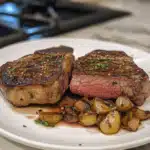There’s just something about the sizzle of a rib eye steak hitting a hot pan that makes dinner feel like an occasion—even if it’s just a Tuesday night. In this article, I’ll walk you through exactly how to make the juiciest, most flavorful rib eye steak from scratch, using simple ingredients and foolproof methods. Whether you’re grilling it outside or pan-searing it indoors, you’ll have everything you need for a steakhouse-style experience right at home.
But first, let me tell you how rib eye steak became my go-to when I want to serve something special.
Table of Contents
Table of Contents

The Juiciest Rib Eye Steak Recipe for Every Home Cook
- Total Time: 30 minutes
- Yield: 2 servings
Description
Juicy rib eye steak cooked to perfection with minimal effort. A flavorful and satisfying dinner any night of the week.
Ingredients
2 rib eye steaks (1-inch thick)
2 tbsp olive oil
1 tbsp steak seasoning or kosher salt & pepper
2 tbsp butter or garlic herb butter
Instructions
1. Let steaks sit at room temperature for 30–45 minutes.
2. Pat dry and rub with olive oil.
3. Season both sides generously.
4. For pan-sear: heat skillet over medium-high heat, sear 2 minutes each side.
5. Transfer to 400°F oven, cook 6–8 minutes for desired doneness.
6. For grill: Preheat to 400°F. Grill 5–7 minutes per side depending on thickness.
7. Use thermometer: 135°F for medium-rare.
8. Rest steaks 5–10 minutes, top with butter, and serve.
Notes
Letting steaks rest helps keep them juicy.
Use a thermometer for best results.
Add garlic cloves or herbs to the pan while searing for extra flavor.
- Prep Time: 5 minutes
- Cook Time: 15 minutes
- Category: Main
- Method: Grilled or Pan-Seared
- Cuisine: American
Nutrition
- Serving Size: 1 steak
- Calories: 690
- Sugar: 1g
- Sodium: 218mg
- Fat: 57g
- Saturated Fat: 23g
- Unsaturated Fat: 30g
- Trans Fat: 0g
- Carbohydrates: 1g
- Fiber: 0g
- Protein: 46g
- Cholesterol: 168mg
From Diapers to Rib Eye Dreams
Hi, I’m Mae—a 38-year-old mom and home cook living just outside of Nashville, Tennessee. My kitchen is where life happens. Between after-school snacks, chaotic weeknights, and the occasional “what’s for dinner?” panic, I’ve found a rhythm that works. And some nights, when I want to feel like a total dinner rockstar without spending hours in the kitchen, I reach for a beautiful rib eye steak.
I still remember the first time I cooked one. My husband and I had just gotten through a particularly rough patch with a newborn and a toddler. We were too exhausted for date night, too broke for takeout, and all I had in the fridge was a couple of thick rib eye steaks I’d snagged on sale. I didn’t have a grill back then, so I heated a cast iron skillet, seasoned the steaks with just salt and pepper, and cooked them until they had a golden crust. A pat of butter on top was the only garnish.
It was the first real meal we’d eaten sitting down in weeks.
That moment made me realize two things: first, rib eye steak is way easier to cook than it looks. And second, food—real, warm, comforting food—can bring you back to life.
Why Rib Eye Steak Is a Cut Above
If you’ve never cooked rib eye steak at home, you’re in for a treat. This cut comes from the rib section of the cow, known for its rich marbling, bold flavor, and tender texture. When people talk about the “steakhouse experience,” it’s often rib eye they’re referring to. Its fat content makes it naturally juicy and flavorful, which means it doesn’t need much to taste amazing.
Rib eye steak can be grilled, pan-seared, oven-finished, or even air-fried if you’re feeling experimental. No matter how you cook it, the key is keeping it simple: a high-quality steak, a hot cooking surface, and a bit of seasoning go a long way.
One of the best parts about rib eye is how accessible it is. You don’t need a fancy marinade, a dry rub, or an expensive sous vide machine. At its core, rib eye steak shines with just salt, pepper, and maybe a brush of olive oil. You can dress it up with a garlic-herb butter or serve it with a bold side dish like creamy roasted garlic mashed potatoes for a complete steakhouse dinner right at your own kitchen table.
And if you’re looking for grilling inspiration or more meat-forward recipes, Spend With Pennies has a helpful Grilling & BBQ section that’s packed with family-friendly meals.
So whether you’re celebrating something special, feeding your crew after a long day, or just craving something hearty and satisfying, rib eye steak delivers every time. Over the next few sections, we’ll dive into exactly how to choose, prep, cook, and serve this superstar cut of beef with confidence.
Because busy moms deserve steak nights, too.

Choosing and Preparing Rib Eye Steak
How to Select the Best Rib Eye Steak
Let’s be honest—standing in front of the meat section at the grocery store can feel a little overwhelming. But choosing the right rib eye steak doesn’t have to be complicated. In fact, picking a great cut is the first step toward a juicy, flavorful meal your whole family will love.
Start by looking for marbling—those white streaks of fat that run through the muscle. More marbling means more flavor and tenderness, which is exactly what you want in a rib eye. Go for USDA Prime or Choice if possible. While Prime has the most marbling, Choice-grade steaks are still excellent and often more budget-friendly, which is something I always keep in mind as a mom feeding five.
Next, consider thickness. A rib eye steak that’s at least 1 inch thick is ideal. Thicker steaks are easier to cook to your preferred doneness without overcooking. And while bone-in steaks bring a little extra flavor, boneless rib eyes are quicker and easier to cook evenly—perfect for busy nights when you need dinner on the table fast.
When visiting the butcher, feel free to ask questions. I often say, “Hey, I’m looking for something tender, great for grilling or pan-searing. What’s your best rib eye today?” Most butchers are happy to help.
Rib Eye Prep Tips for Flavor and Juiciness
After choosing the perfect steak, preparation is key. The good news? Rib eye steak doesn’t need much to shine. In fact, less is more.
The first step is thawing—especially if you pulled it from the freezer last minute. Pressed for time? Here’s a fast way to thaw your steak:
- Place the sealed steak into a bowl filled with cold water.
- Change the water every 20 minutes.
- Depending on its thickness, the steak should defrost in less than an hour.
Whatever you do, don’t use hot water or a microwave. You’ll lose the texture and that juicy bite we’re aiming for.
After defrosting, let the steak sit out for 30 to 45 minutes so it reaches room temperature before cooking. This helps it cook more evenly. Then pat it dry with paper towels. Excess surface moisture leads to steaming instead of a proper sear.
For seasoning, you can keep it classic with just kosher salt and cracked pepper, or use a favorite blend like Montreal Steak Spice. Personally, I like to rub the steak with a touch of olive oil, then season generously on both sides. The oil helps the spices stick and gives the steak that irresistible crust.
Don’t forget to preheat your cooking surface—whether that’s a hot cast iron skillet or your gas grill. That first sizzle means you’re locking in the flavor.
Cooking Rib Eye Steak to Perfection
How to Cook Chuck Rib Eye Steak at Home
Let’s talk about chuck rib eye steak—a budget-friendly version of the classic rib eye that’s full of flavor. While it has a slightly different texture due to being cut closer to the shoulder, it still delivers rich marbling and tenderness when cooked right. I like to think of it as rib eye’s rugged cousin: a little more rustic, but just as satisfying.
To make a chuck rib eye steak that’s juicy and fork-tender, the pan-sear and oven-finish method is my favorite. Here’s how I do it, step by step:
- Allow the steak to sit at room temperature for around 30 minutes.
- Pat it dry with paper towels and rub with olive oil.
- Season generously with kosher salt and black pepper (or your favorite steak blend).
- Heat a cast iron skillet over medium-high heat until it’s blazing hot.
- Sear the steak without moving it for 2 minutes per side.
- Move the skillet to a 400°F oven and roast for the following time:
- 6–7 minutes for medium-rare
- 8–9 minutes for medium
Check the internal temperature with an instant-read thermometer—135°F for medium-rare. Once done, remove the steak, top with a pat of butter, and let it rest 5–10 minutes before slicing.
Add garlic cloves and rosemary to the pan while finishing in the oven for extra flavor. This simple trick makes it feel like you’ve leveled up your entire meal.
And if you’re making this as part of a larger dinner, pair it with creamed spinach or buttery mashed potatoes. It’s the kind of cozy plate that even picky eaters will love.

How to Grill Rib Eye Steaks on a Gas Grill
Now, if you’re like me and enjoy taking dinner outside when the weather’s nice, nothing beats a grilled rib eye. Grilling brings out a slightly smoky flavor and gives you those beautiful charred grill marks that feel like summer—even in March.
Here’s exactly how to grill rib eye steaks on a gas grill:
- Take the steaks out of the fridge and let them sit for 30–45 minutes to reach room temp.
- Set your gas grill to medium-high heat, around 400°F, and let it preheat.. Clean and oil the grates.
- Rub the steaks with olive oil and season liberally on both sides.
- Place steaks on the grill and close the lid.
- Grill for:
- 4–5 minutes per side for medium-rare
- 6–7 minutes per side for medium
Use a meat thermometer if you’re unsure. Aim for 135°F for medium-rare and remove the steak a few degrees early—it’ll continue cooking as it rests.
After removing from the grill, add a pat of butter and loosely cover with foil. Let the rib eye rest for 5–10 minutes. This step locks in the juices so each bite is buttery and tender.
Bonus tip: Want to take it up a notch? Add a drizzle of homemade garlic butter or a splash of Worcestershire sauce while it rests. It’s magic.
Grilled rib eye pairs beautifully with oven-roasted potatoes or even a simple Caesar salad to balance out the richness. And if you have leftovers, thin-slice them for steak sandwiches the next day—one of my favorite mom hacks.
Serving, Nutrition & Side Dishes
Calories in Rib Eye Steak + Nutrition Info
Rib eye steak isn’t just tasty—it’s a great source of protein, healthy fats, and key nutrients.But how many calories are in rib eye steak? That depends on size, fat content, and how you cook it.
Here’s a breakdown based on a standard 1-inch thick, boneless rib eye steak (approximately 8 oz cooked):
| Nutrient | Amount (Approx.) |
|---|---|
| Calories | ~690 kcal |
| Protein | 46g |
| Fat | 57g |
| Saturated Fat | 23g |
| Cholesterol | 168mg |
| Sodium | 218mg |
It’s definitely a hearty meal, so I like to balance it with lighter sides. Think grilled vegetables, fresh salad, or low-carb options like roasted cauliflower. The key is to balance the richness with something light and refreshing.
For moms like me who love efficiency, I’ll often roast my sides right in the oven while the steak finishes—less fuss, more flavor.
What to Serve with Rib Eye Steak
Rib eye steak is bold and rich, which makes it the star of the plate. But a good supporting cast of sides turns it into a full experience. Here are a few favorites:
- Creamy Garlic Mashed Potatoes – Comfort food at its best.
- Oven Roasted Potatoes – Crispy outside, fluffy inside.
- Caesar Salad – Adds freshness and crunch.
- Garlic Herb Mushrooms – Cook them right in the steak drippings.
- Creamed Spinach or Asparagus – Great for low-carb or keto-friendly meals.
On busy weeknights, I even serve rib eye with a simple bowl of homemade soup or leftover rice and steamed broccoli. Simple can still be incredibly tasty.
Want to go steakhouse style? Add a pat of garlic butter and a glass of red wine. It instantly elevates the whole meal—even if your kids are eating mac and cheese next to you.
While your steak is resting, treat yourself to a quick dessert like this Brownie in a Mug with Swiss Miss—it’s ready in minutes and satisfies that sweet tooth without the mess.

Conclusion
Rib eye steak isn’t just a meal—it’s a moment. This is the kind of meal that makes an ordinary evening feel special. Whether you’re pan-searing a chuck rib eye on a Wednesday or grilling a prime cut on Saturday, the result is always rewarding.
As a mom who learned to cook between nap schedules and laundry piles, I know the value of recipes that actually work. That’s why I come back to rib eye steak time and time again. It’s fast, forgiving, and so satisfying. With a little know-how and a hot pan or grill, you’ve got dinner that feels like a win.
So go ahead—grab that steak, season it with confidence, and don’t skip the butter. You’ve got this. And your family? They’ll be asking for seconds.
Welcome to The Recipe Lounge—where real-life cooking meets juicy, flavorful wins.
Follow me on Facebook and Pinterest for new recipes, mom-tested kitchen tips, and sweet ideas from my family kitchen!
Frequently Asked Questions
How many calories in rib eye steak?
An 8-ounce cooked rib eye steak has about 690 calories, depending on the cut’s fat content and cooking method. Rib eye is naturally higher in fat, which makes it extra flavorful but also more calorie-dense than leaner cuts.
How to cook chuck rib eye steak?
Chuck rib eye is best when seared and oven-finished. Sear for 2 minutes per side in a hot skillet, then transfer to a 400°F oven for 6–8 minutes. Let it rest for 5–10 minutes before slicing to keep it juicy.
How to grill rib eye steaks on a gas grill?
Preheat your grill to 400°F. Season steaks and grill 4–7 minutes per side based on thickness and doneness. Use a thermometer (135°F for medium-rare) and rest for 5–10 minutes before serving.
How to rapidly thaw steak?
Place your sealed steak in a bowl of cold water. Change the water every 20 minutes. It should thaw in under an hour. Avoid hot water or microwaves to protect texture and flavor.
How to defrost a steak faster?
The cold water method is your best bet. If you’re short on time, vacuum-sealed steaks defrost even quicker. Never thaw at room temperature for long—it’s not food safe.


